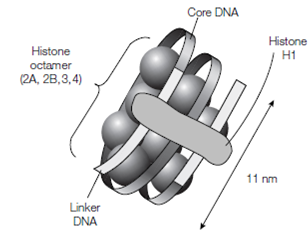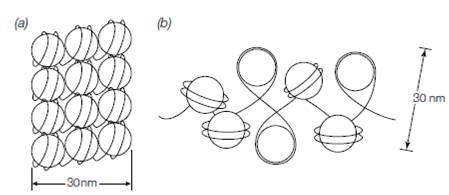30 nm fiber:
30 nm fiber If nuclei are lysed extremely gently, the chromatin is seen to exist as a 30 nm diameter fiber. This diameter is much bigger than a single nucleosome which is about 11 nm and suggests which the nucleosomes are organized into a higher order structure. The fiber is formed through a histone H1 molecule binding to the linker DNA of each nucleosome at the point where it enters and leaves the nucleosome. The histone H1 molecules interact with every other pulling the nucleosomes together. Precisely how the nucleosomes are organized to form the 30 nm fiber is not known; one possibility is in which the nucleosomes wind up into a higher order helix with six nucleosomes per turn to form a solenoid shown in the figure. This would give a fiber three nucleosomes broad that is indeed the diameter experiential. In like

figure: Schematic diagram of a nucleosome consisting of the DNA double helix wound 1.8 times round a histone octamer (two molecules each of histones H2A, H2B, H3 and H4).

figure: (a) The proposed solenoid model of chromatin to yield a 30 nm fiber. The structure consists of six nucleosomes per turn of the helix and hence would be three nucleosomes wide. In the diagram, only three nucleosomes of each turn are visible; the other three nucleosomes per turn are hidden from view. (b) Zigzag model. For each nucleosome, the DNA is wound round the outside (1.65 turns of a left-handed supercoil).
However in this simple diagram, because of the orientation of some nucleosomes, not the entire DNA supercoil is shown.
a solenoid the linear length of the DNA has been decrease through a further factor of 6 equivalent to six nucleosomes per turn of the solenoid. A Coupled with the packing ratio of 7 for the nucleosome itself, this gives a packing ratio for the solenoid of around 6× 7 (i.e. about 40). A way model is the zigzag model shown in the figure.